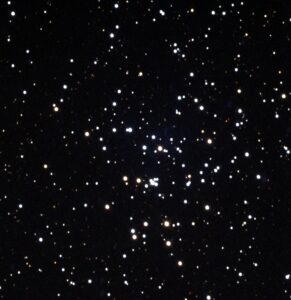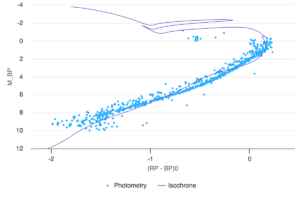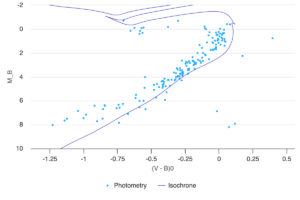NGC 2360, also known as ‘Caroline’s Cluster’, is an intermediate cluster that is located in the southern constellation Canis Major. It was first discovered by Caroline Herschel, however was never officially brought to attention until her brother William included NGC 2360 in his 1783 catalog of 1000 star clusters and nebulae.
In a recent study, Olin J. Eggen (1968) discovered that what was thought to be the brightest star in the field (known as magnitude-8.96 HD 56847) is most likely to not be a true member of the cluster, but rather a field star.
In order to study NGC 2360 and investigate the relationships between the colours, brightnesses, and the age and chemical composition of the cluster as a whole, I collected images in B, V, and R filters with a Prompt5 telescope, with total exposure durations of 104.84s, 56.45s and 32.26s respectively using Skynet. I used Afterglow to create a batch photometry image of the cluster using my B, V, and R images as shown here:


Using Cluster Astromancer, I graphed and plotted my cluster on GAIA charts, using RP – BP VS RP, V – B vs V, and R – B vs R.



With these graphs, I found these basic results about distance, proper motion, etc:
RA: 109.44
Dec: -15.63
Galactic Longitude: 49.803
Galactic Latitude: -1.412
Angular Radius: 0.134
Proper Motion RA: 0.39 (mas/yr)
Proper Motion Dec: 5.63 (mas/yr)
Velocity Dispersion: 0.17 (mas/yr)
Distance: 1.08 (kpc)
Log Age: 8.5 log(yrs)
Age: 316.23 (Myrs)
Metallicity: -1.1 (solar)
Reddening: 0.49 (mag)
This cluster was a bit difficult to study, as it showed up in Astromancer as sort of two clusters at once. It took me a while to finally narrow it down enough so it would fit, while also not including too many extra field stars.
Admittedly, I’m still a bit puzzled on the assignment overall. Even if I didn’t do as good as I had hoped for, I still found researching this cluster was interesting and enjoyable nonetheless.